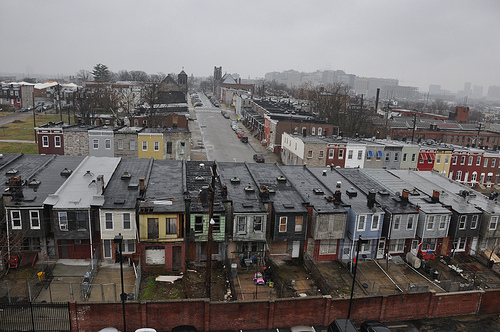Regreening Baltimore

Baltimore’s Oliver Neighborhood is a mix of occupied and abandoned rowhouses. The U.S. Forest Service is working with partners to host the Carbon Challenge green building design contest, promoting sustainable and livable neighborhoods in Baltimore and Providence, R.I. (L.F. Chambers, U.S. Forest Service photo)
Depending on who you talk to, there are between 16,000 and 20,000 vacant homes in Baltimore. Once a mid-20th century boomtown where residents built the liberty ships and liberator bombers that helped win World War II, the middle-class dreams of this city have been in a decades-long decline. Entire blocks stand empty, lifeless veneers of boarded windows and burnt-out roofs.
But the U.S. Forest Service is working to help change that, promoting livable and workable buildings for 21st-Century occupants, while retaining the vibrant culture and community that once characterized these streets.
The agency, in partnership with Baltimore Mayor Stephanie Rawlings-Blake, the Engineered Wood Association and the American Institute of Architects, recently kicked off the Carbon Challenge, a home-design competition promoting the use of wood as a green building material and offering cash prizes totaling $10,000. Competition participants will design an iconic urban row house to help the city restore distressed neighborhoods and implement the mayor’s sustainability plan. The designs will be judged on their life-cycle assessment score, best curb appeal, affordability and the best use of wood.
“Wood should be a major component of American building and energy design,” said Harris Sherman, U.S. Department of Agriculture Under Secretary for Natural Resources and the Environment. “The use of wood products continues to benefit the environment by storing carbon long after a building has been constructed, and helps sustain a critical source of jobs in rural America. This project could be a blueprint for developing communities in cities across America.”
Another Carbon Challenge is underway in Providence, R.I., where contestants are designing a single-family home for Habitat for Humanity.
The USDA announced a new emphasis on the use of green building materials in March 2011, requiring all new USDA buildings to use wood in their construction and promoting new research into the use of wood as an environment-friendly building material. Forest Service studies show that using wood products for building materials, instead of fossil-fuel intensive alternatives, results in a smaller carbon footprint.
The Carbon Challenge addresses the needs of low- and middle-income residents, providing viable green and economic benefits to those who need it most, and demonstrating that sustainability actions can be affordable.
“The Baltimore row house has often been the image most people associate with the city,” said Morgan Grove, lead research forester of the Forest Service’s Baltimore Field Station. “While we work to produce a template for a more sustainable row house for the city, we hope to eventually realize a built version of the winning design. The structure would be a demonstration model for people to visit, as well as provide housing for local students volunteering to improve the neighborhood.”

There’s no jobs? Look at the potetial if industry would take a stand at developing there. I’m sure tax incentives,real estate,housing,etc. could benefit everyone in that area. We don’t have to go overseas for expense benefits. Manufacturing could take place right here.
I hope to be part of this program in the near future to come.
Thanks
Abraham.
Were B-24 Liberator bombers or Martin B-26 Marauder bombers built in Baltimore?
Nice catch, Jeff! It was indeed the Martin Marauder that was built in Baltimore, and not the Liberator (which was built by Consolidated Aircraft in San Diego, apparently). I’ll see that it’s corrected today.
kind regards,
Larry Chambers